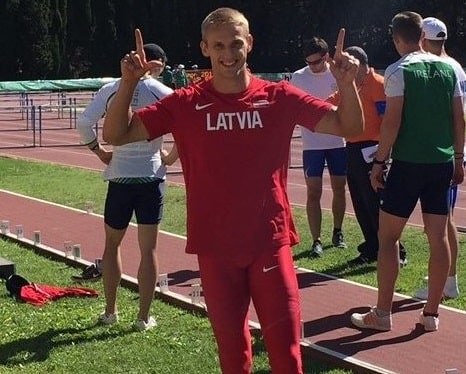A pre-competition routine of an elite track athlete

Since we are about to enter the main indoor championship season (National Championships, Collegiate Conference meets, Regional Championships), it is appropriate to talk about pre-competition routines. This is what the best of the best do in order to prep their bodies for elite performances.
Nutrition
Many young and inexperienced athletes tend to think that it’s sufficient to fix their bad eating habits a week or two before the main championships. Although, it seems to always be a good idea to fix a bad eating pattern, pre-competition time might not be the best time to do so. It might hurt you rather than help you, especially, if you go ‘cold turkey’ from very bad eating to very good eating right before competition.
Good, balanced diet must be a routine that takes places before, during and after your most important competitions, (with an exception of off-season where you might be able to afford some cheat foods once in a while.) Clean eating must be a lifestyle that includes plenty of colorful vegetables, fruits, berries, nuts and seeds, quality protein and fat sources as well as slow and fast digesting carbohydrate sources, such as whole grains, (rice, bulgur, buckwheat, quinoa etc.) or root vegetables, (many kinds of potatoes, beets, carrots etc.) Big emphasis for athletes should be on green leafy vegetables, such as, broccoli, kale, spinach, lettuce, cabbage due to its high antioxidant and phytochemical content that helps with recovery and boosts immune system.
If you are not in this place yet, that’s okay. You must work with what you have. The most important thing before competition is to stick with what you are used to. Do not try to experiment with new foods before major competitions. That can be disastrous, as it takes time for the body to adapt to new foods. It might be beneficial for some track athletes to lower the carbohydrate intake while increase the fat and protein intake to lose some body weight. By temporarily decreasing (not excluding) carbs and salt in the diet, it helps get rid of the excess water from the cells that bind with carbohydrates and sodium when consumed. (Rakova, Natalia, et al., 2017) For example, each gram of carbohydrates is bound by 2.4 grams of water in the liver. (Nilsson, L. Hson, 1973).
On the competition day, it is important to keep the fast sugars off the table, as they induce quick energy spikes followed by energy level crash soon after. Carbohydrates are good and needed, to some event athletes more than others, but you must be careful in what kinds of carbs you choose. In the main meals its best to choose slow releasing carbs that provide with energy over time. During competition, however, it is beneficial to take some fast release carbs to maintain the competition focus and clarity and restore the glycogen stores in the liver and the muscles.
Hydration
Hydration becomes a very important topic with heat conditions as well as long airfare travelling and altitude changes. Hydration might be one of the most controversial topics in the field of sports performance. Being hydrated no doubt is a good thing. What does it mean - being hydrated? That is where the sports drink lobby makes big profit, especially in the U.S. Simply said - consume plenty of fluids throughout the day, a little extra about a week before the major competitions, and your body will be thankful, and you will perform well. Constant awareness helps. Avoid sugary drinks because they will add unnecessary calories and water weight (as already mentioned above).
Mobility/soft tissue work
Stay mobile. Track athletes tend to get stiff in the hip flexors, extensors (quads, iliopsoas, glutes and other muscle groups depending on the event). This is typical for the competition season time because the training intensity is higher, and body must take on lots of beating. Getting stiff is protective mechanism or our muscles and joints. Some joints require stiffness, like in the feet, knees and lumbar pelvic region, elbows while others are made to be mobile, like ankles, hip, thoracic spine, shoulders etc. In-season, especially, before competitions, it’s important to work on active mobility exercises that allow full range movements in the joints your event requires to use the most. The right length-tension ratio is necessary for muscle fibers to work as effectively as possible. PNF (proprioceptive neuromuscular facilitation) method might be a good option for this.
It is also important to apply some kind of soft tissue work. Foam roller and ball rolling can be a cheap option, better might be a myofascial release massage, trigger point release or other techniques. Pre-competition goal is to help the muscles be fresh and ready to fire smoothly and effectively at the right time. No need to overdo it. Neither extra mobility beyond what is functional, nor extra massages will help if done excessively. Be consistent but not excessive!
Sleep/wake-up
Good athletes know that if there is one tool that can make you or break you before important meets, it’s sleep. This aspect is often a forgotten part of training. This is where you are forming your shape. Robert Zmelik, Olympic decathlon champion from Barcelona 92’ Olympics has said that a good shape comes when you rest well and patiently wait like a crocodile before the attack. A few pre-conditions that can help with sleeping well: Keep caffeine far enough from your sleep time, preferably keep it in the AM. Have dark, quiet environment. No screen devices about one hour before bedtime. Avoid large meals close to bedtime. Give yourself an opportunity to have 8 hours of sleep at least a week or two before the major championships. Also don’t “try” falling asleep. It doesn’t work. Let go of control and embrace the resting time. Arthur Abele, the European decathlon champion from 2018 has said that he tries to go to bed at around 10PM 3 weeks prior to the major decathlon championships. It’s better to go to bed earlier and wake up earlier than the other way around. Also, try to wake up at the same time. Our bodies love consistency in our sleeping routines. Training well is important, however, sleeping well close to the important meets it’s even more important.
Mindset
You have done the work. Remember that a week before championship is not the time to do long, exhausting trainings. This is the time when you are doing the final touch ups, and not the bulk work. This is where you enter the performance stage and allow your coach to sit back and enjoy your performance. Trust the training process, stay humble but confident.
Pre-meet warm up/neuromuscular warm-up
This is where it can get very individual. Some athletes prefer to do a pre-meet warm-up two days before competition, and rest the day prior, while others feel the best when they do the pre-meet warm-up a day prior the competition. Regardless of the choice, it is important to keep the neuromuscular system alert and ready to fire. It can be done in multiple ways. Good options include ballistic exercises, such as medicine ball/shot throws, plyometrics, dynamic weights, short speed drills or a combination of them. You must find your own routine that activates your body the best.
The same goes with neuromuscular warm-up in the morning of competition. Some athletes prefer to keep it to a minimum like a contrast shower or walking combined with light mobility, while others benefit from jogging, some sprint exercises and even light plyometric exercises. Neuromuscular warm-up works, again - you must find what exactly and how it looks for you.
Now it’s time to get ready. Be a crocodile. Expect nothing and fight for everything!





Comments